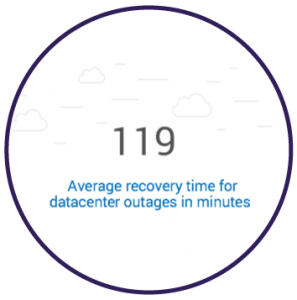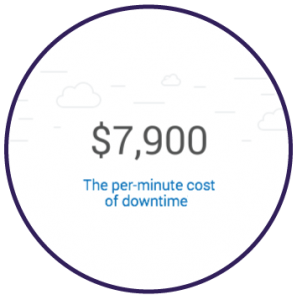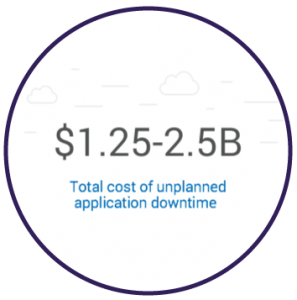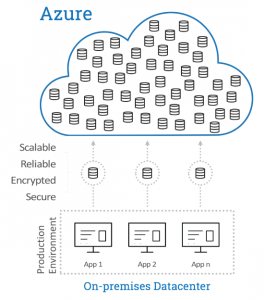The rise of cloud computing, big data, and BYOD in the work environment has made it increasingly challenging to protect your organization’s data.
Small businesses often make the false assumption that their data isn’t as vulnerable to compromise as big corporations, but this is proving to be an incorrect and potentially costly assumption. The National Archives and Records Administration reports that more than 90 percent of companies that experience at least seven days of data center downtime go out of business within a year.



So what’s your plan to ensure that downtime doesn’t collapse your company? You need a comprehensive disaster recovery plan in place using a trusted solution like Azure Site Recovery before disaster strikes.
Cost vs. Complexity
When creating your disaster recovery plan, you’ll need to weigh the trade-offs between complexity and cost. What data can you afford to be without? For how long? If you lost some data, would that destroy your business forever? To answer those questions, let’s look at what your plan needs to include.
Five parts of a disaster recovery plan:
- Recovery Point Objective (RPO): RPO defines how much data you are willing to lose. You can give higher priority to saving your most critical data, while being willing to lose less important data, such as pictures of the Christmas party (which may be better off that way!). Customer records might be top of your list, while marketing data might rank lower.
- Recovery Time Objection (RTO): RTO weighs how long you are willing to be without your data. Depending on your business, you might decide that you can lose up to two hours of business operation. A higher time will create higher costs, so you’ll need to consider your options carefully.
- Personnel: Who should get their data back sooner? Who will support the plan? Do you have a backup person as well as backup technology? Is your plan dependent on human intervention, which may not be possible in all cases?
- Regulatory constraints: Is your business subject to regulatory compliance? How will you make sure you are covered?
- Critical data: Which data is critical to your business? What are the dependencies between different areas of the business?
Find a solution that fits your disaster recovery plan
A cloud solution can help you find a good balance between cost and complexity while fulfilling the requirements you’ve outlined in your plan. With Azure Site Recovery, you can easily create disaster recovery plans in the Microsoft Azure portal that can be as simple or as advanced as your recovery plan demands.
 For small and medium businesses, you can protect all of your major IT systems inexpensively by implementing disaster recovery to the cloud using Site Recovery. It integrates with other BCDR technologies and you can set up and manage replication, failover, and failback from a single location in the Azure portal.
For small and medium businesses, you can protect all of your major IT systems inexpensively by implementing disaster recovery to the cloud using Site Recovery. It integrates with other BCDR technologies and you can set up and manage replication, failover, and failback from a single location in the Azure portal.
Site Recovery can also help you meet your RTO and RPO requirements since Azure VMs can be replicated between Azure regions as a part of your strategy. When failover occurs, Azure VMs are created based on the replicated data. Site Recovery provides continuous replication for Azure VMs and VMware VMs, and replication frequency as low as 30 seconds for Hyper-V.
Finally, Site Recovery integrates with Azure for simple application network management, including reserving IP addresses, configuring load-balancers, and integrating Azure Traffic Manager for efficient network switchovers. Learn more about Microsoft’s complete integrated Azure cloud solution for backup and recovery.
Train and test
Once you have a plan in place you’ll need to train all personnel. You’ll increase your chance of success when upper management endorses the plan and promotes training for all employees. Communicating the plan and even incorporating it in new employee training might be good strategies as well. Assuming everyone knows who is responsible for what can lead to failure.
Too often companies will create a plan, implement it and then stick it in a file. They don’t fully test the plan, or consider multiple scenarios. When a disaster hits, whether its cybercrime, a natural disaster or that rogue sprinkler system, the plan fails. The New York Stock Exchange had a plan before Hurricane Sandy, but they didn’t follow it when disaster hit – instead they closed the stock exchange for two days.
Your resources and business needs will evolve over time because location, personnel, and data changes. Annual training, and testing two to three times a year is the best way to make sure the plan is up-to-date, still supports your current business goals, and everyone is prepared for a short, efficient recovery with as little down time as possible.
Your disaster recovery plan can’t wait
Nobody likes to think about their business getting hit by a disaster, and hopefully you never will, but facts show that you are likely to experience some level of compromise at some point.
Azure Site Recovery is a trusted and robust solution that can help you recover quickly from disaster. It monitors the state of your protected instances continuously and remotely from Azure. When replicating between two sites that you control, your virtual machines’ data and replication stays on your networks and all communication with Azure is encrypted. You can also select encryption for data at rest.
You can’t guarantee you won’t be affected by cyberattack, natural disaster, technical malfunction and uncontrollable human error, but you can protect your business from costly data loss by investing in a solution that aids in data backup and disaster recovery.
We can help you along the way
We’re here to help with all stages of strategy, planning and implementation. We can discuss your needs and help you explore all your available options, including the advantages of cloud BU and DR. Don’t wait any longer.





